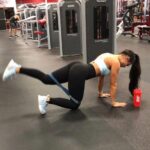A casual fitness routine is a great way to stay active and healthy, even for those with a hectic schedule. In today’s fast-paced world, finding time for exercise can be a challenge, but incorporating a casual fitness routine into your daily life can have numerous benefits.
Whether you’re a busy professional, a parent with young children, or simply someone with limited free time, implementing a casual fitness routine can help you stay fit and energized without feeling overwhelmed.
When it comes to fitness, setting realistic goals is key to success. For those with busy lifestyles, it’s essential to establish achievable fitness goals that can easily be integrated into your everyday routine. Whether it’s aiming for a certain number of steps each day or committing to a few short workout sessions per week, these realistic goals will help keep you motivated and on track.
In the following sections, we’ll explore different types of workouts suitable for a casual fitness routine, offer tips for scheduling and time management, discuss strategies for staying motivated and consistent with your workouts, and address the importance of rest and recovery. Additionally, we’ll delve into the role of nutrition in supporting a casual fitness routine and provide guidance on making fitness a long-term lifestyle change.
So if you’re ready to embrace a more relaxed approach to staying active while managing your busy lifestyle, read on for valuable insights and tips on establishing a casual fitness routine that works for you.
Setting Realistic Goals
Setting realistic fitness goals is crucial when establishing a casual fitness routine. For individuals with busy lifestyles, it can be challenging to find the time and energy for rigorous workouts. This is why setting achievable goals is essential for maintaining motivation and consistency. Whether the goal is to improve flexibility, build strength, or simply incorporate more physical activity into daily life, it’s important to establish realistic expectations.
When setting fitness goals for a casual routine, it’s essential to consider personal limitations and lifestyle constraints. For example, someone with a demanding work schedule may not have the time for lengthy gym sessions every day. In this case, setting a goal of fitting in three 30-minute workouts per week may be more achievable. By acknowledging individual circumstances and capabilities, individuals can avoid feelings of failure or disappointment if they’re unable to meet unrealistic expectations.
It’s also important to set measurable goals that can track progress over time. This could include specific targets such as increasing the number of push-ups completed in a minute, being able to hold a yoga pose for a longer duration, or walking a certain distance without rest. Tracking progress allows individuals to see their improvement, serving as motivation to continue with their casual fitness routine.
| Setting Realistic Goals | Discussing the Importance of Setting Achievable Fitness Goals for a Casual Routine |
|---|---|
| Flexibility improvement | Build strength |
| 30-minute workouts per week | Measurable targets |
Finding the Right Workout
When it comes to maintaining a casual fitness routine, finding the right workout is essential for both enjoyment and effectiveness. For those with busy schedules, it’s important to choose workouts that are convenient and can be easily integrated into daily life. Popular options for casual fitness routines include yoga, walking, and bodyweight exercises.
Yoga is an excellent choice for individuals looking to incorporate both physical activity and relaxation into their routine. With various styles such as Hatha, Vinyasa, and Yin yoga, there are options for people of all fitness levels and preferences. Many yoga classes also focus on breathing techniques and mindfulness, offering a holistic approach to health and wellness.
Walking is another simple yet effective workout option for those with limited time. Whether it’s taking a brisk walk during lunch breaks or incorporating walking meetings into the workday, this low-impact exercise can help improve cardiovascular health, boost mood, and increase overall daily activity levels.
For individuals who prefer to work out from home or without specialized equipment, bodyweight exercises are a great choice. These exercises use the body’s own weight as resistance and can be modified to accommodate different levels of strength and endurance. Examples of bodyweight exercises include squats, push-ups, lunges, planks, and burpees.
Incorporating these types of workouts into a casual fitness routine can not only make physical activity more accessible but also contribute to long-term adherence to a healthy lifestyle. The versatility of these workout options allows individuals to maintain consistency in their fitness habits regardless of their daily commitments.
| Workout Option | Benefits |
|---|---|
| Yoga | Versatile styles suitable for all fitness levels; emphasizes both physical activity and relaxation |
| Walking | Low-impact exercise that improves cardiovascular health; can be easily integrated into daily routine |
| Bodyweight Exercises | No need for special equipment; customizable based on individual strength and endurance level |
Scheduling
When it comes to incorporating a casual fitness routine into a busy schedule, time management and prioritizing workouts are crucial components. Finding the time to exercise can be challenging, but with the right strategies, it is possible to make fitness a priority.
Effective Time Management
One of the key aspects of integrating a casual fitness routine into a busy schedule is effective time management. This means identifying pockets of time throughout the day that can be dedicated to exercise. Whether it’s waking up a little earlier in the morning, utilizing lunch breaks for a quick workout, or setting aside time in the evening, finding small increments of time can add up to create a consistent fitness routine.
Prioritizing Workouts
Prioritizing workouts involves making exercise a non-negotiable part of your daily or weekly schedule. Just like any other commitment, blocking out specific times for exercise and treating them as essential appointments can help ensure that they don’t get pushed aside when things get busy. It may require saying no to other obligations or reorganizing your schedule, but prioritizing workouts is essential for maintaining a casual fitness routine.
Finding Balance
In the context of a busy schedule, finding balance is also important when integrating a casual fitness routine. It’s crucial to allocate time not just for workouts, but also for rest, relaxation, and other responsibilities. Striking a balance between work, personal life, and exercise is key to avoiding burnout and ensuring that the casual fitness routine is sustainable in the long run.
By implementing effective time management strategies and prioritizing workouts as non-negotiable commitments, individuals can successfully integrate a casual fitness routine into their busy schedules and reap the physical and mental benefits of regular exercise.
Staying Motivated
Tracking Progress
One effective strategy for staying motivated is to track progress. This could involve keeping a workout journal to record the type of exercise, duration, and intensity, as well as any improvements in strength or endurance. Some people may also find it helpful to take regular measurements or photos to visually see the changes in their body over time. By tracking progress, individuals can see the tangible results of their efforts, which can be incredibly motivating.
Finding Accountability Partners
Another way to stay motivated is by finding accountability partners. This could be a friend, family member, or coworker who also has a casual fitness routine and can provide support and encouragement.
Many people find that having someone else to share their fitness journey with helps them stay committed to their goals. Whether it’s scheduling regular workout sessions together or simply checking in on each other’s progress, having an accountability partner can make a significant difference in staying consistent with a fitness routine.
Rewarding Yourself
Additionally, rewarding yourself for reaching milestones or sticking to your routine can help keep you motivated. This could involve treating yourself to something you enjoy after completing a certain number of workouts or achieving a specific goal. By associating positive rewards with your fitness efforts, you create positive reinforcement that reinforces your commitment to your casual fitness routine.
Recovery and Rest
When it comes to a casual fitness routine, it’s important to understand the significance of rest and recovery. While consistency is crucial for progress, giving your body the time it needs to recover is equally important. Without proper rest, you risk burnout and injury, ultimately hindering your fitness journey. Here are some tips for understanding the importance of rest and recovery in a casual fitness routine, and how to avoid burnout:
1. Listen to Your Body: One of the first steps in avoiding burnout is learning to listen to your body. If you’re feeling excessively fatigued or experience persistent muscle soreness, it may be a sign that you need to dial back on your workouts or incorporate more rest days into your routine.
2. Incorporate Active Recovery: While taking complete rest days is essential, incorporating active recovery can also aid in preventing burnout. Consider activities like gentle yoga, stretching, or low-intensity walks on your off days from intense workouts.
3. Prioritize Sleep: Adequate sleep is vital for overall health and muscle recovery. Aim for 7-9 hours of quality sleep each night to support your casual fitness routine and ensure your body has the opportunity to repair and recharge.
Remember that rest and recovery are not signs of weakness but rather essential components of any successful fitness regimen. By understanding the role they play in a casual fitness routine, you can continue making progress while also avoiding burnout.
Nutrition
When it comes to maintaining a casual fitness routine, nutrition plays a crucial role in supporting overall health and fitness goals. Here are some tips for incorporating healthy eating into a busy schedule:
- Meal Prep: One of the best ways to ensure you’re eating healthy despite a hectic schedule is through meal prepping. Take time at the beginning of the week to prepare and package meals that you can easily grab on-the-go.
- Snack Smart: Keep nutritious snacks on hand, such as nuts, cut-up fruits and vegetables, and low-fat yogurt. These can help you resist the temptation of reaching for unhealthy options when hunger strikes.
- Hydration: Staying hydrated is essential for overall health and energy levels. Always carry a water bottle with you and aim to drink at least 8 glasses of water per day.
It’s also important to focus on consuming a well-balanced diet that includes a variety of nutrients such as lean proteins, whole grains, fruits, vegetables, and healthy fats. Strive to limit processed foods, sugary drinks, and excessive amounts of caffeine.
In addition to meal planning and making mindful food choices, seeking out professional guidance from a nutritionist or dietitian can provide personalized recommendations for your specific lifestyle and fitness goals. By fueling your body with the right nutrients, you can optimize the results of your casual fitness routine while still managing a busy schedule.
Making It a Lifestyle
In conclusion, a casual fitness routine can be an excellent way for individuals with busy lifestyles to prioritize their health and well-being. By setting achievable goals, finding the right workout, and scheduling exercise into their daily routine, individuals can make significant strides towards improving their fitness levels. Additionally, staying motivated, allowing for proper recovery and rest, and focusing on nutrition are all essential aspects of maintaining a sustainable casual fitness routine.
It’s important for those following a casual fitness routine to understand that this is not just a short-term fix, but rather a long-term lifestyle change. By viewing fitness as an integral part of their daily lives, individuals can experience lasting benefits such as increased energy, improved mental well-being, and better overall health.
It’s crucial to remember that consistency is key when it comes to casual fitness routines, and making small changes over time can lead to significant improvements in one’s physical and mental health.
Ultimately, embracing a casual fitness routine as a lifestyle rather than a temporary solution can lead to lasting positive changes. Finding enjoyment in the journey towards better health and well-being is essential for maintaining long-term motivation. By incorporating these strategies into their daily lives, individuals can achieve their fitness goals while still managing the demands of a busy schedule.
Frequently Asked Questions
What Should a 7 Day Workout Routine Look Like?
A 7 day workout routine should ideally include a mix of cardio, strength training, and flexibility exercises. It’s important to vary the type and intensity of workouts throughout the week to allow for proper recovery.
What Is a Good Routine to Get Fit?
A good routine to get fit typically includes a combination of cardiovascular exercises like running or cycling, strength training with weights or bodyweight exercises, and flexibility work such as yoga or stretching. Consistency and gradual progression are key.
What Is a Minimalist Workout Routine?
A minimalist workout routine focuses on basic exercises that target multiple muscle groups at once, such as squats, push-ups, and lunges. The goal is to be efficient with time and still achieve a full-body workout with minimal equipment.

Passionate about providing useful information to anyone with an interest in the field of Personal Training, I strive to pass on to our readers quality information and to answer any questions about Personal Trainers, the work they do and how to become one.





